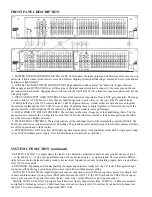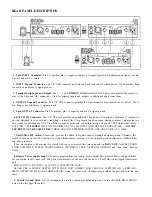
Before attempting any equalization of audio with the GQ
15/GQ 30, it is important to optimize the IN and OUT
GAIN control settings. Improper gain distribution is a com-
mon cause of headroom loss and increased noise in audio
systems.
The GQ 15/GQ 30 provides you with an overall BYPASS
switch & indicator as well as an OL (overload) LED as
useful tools for optimizing this gain set-up. The BYPASS
switch is useful for making quick A-B comparisons, i.e.,
comparing equalized (BYPASS out, LED off) versus une-
qualized (BYPASS in, LED on) sound. To do this freely,
without danger of system damage, requires you set the
level through the GQ 15/GQ 30 to approximately unity.
Failure to do so can produce alarming results.
The input and output gain ranges of the GQ 15/GQ 30 go
from -12dB to + 12dB The GQ 15/GQ 30 is always unity
gain in bypass, so if you add or reduce gain (beyond EQ
make-up gain) the level differences between BYPASS
in/out can be startling. Therefore you want to set the
GAIN controls for equal in/out loudness levels.
To get started, make the following initial set-up adjust-
ments:
1. BYPASS switch depressed (equals bypassed condition
= red LED on).
2. Both GAIN controls positioned at the top of the panel,
i.e., IN @ + 12 and OUT @ -12.
3. All slide controls center-detent positions (0dB
boost/cut).
4. Apply a signal to the system.
5. Check that the OL indicator is not on. If the OL LED
is on, move both GAIN controls down just enough for it to
go out. The GQ 15/GQ 30 stays unity gain from input to
output because you kept both controls at equal settings,
thus ensuring the input is attenuated enough to keep it out
of overload and the output gain is making up for it. For op-
timum noise performance always take as much gain as pos-
sible through the INPUT stages, i.e., position the IN GAIN
slider as close to +12dB (the OUT GAIN slider toward
-12dB — keep them together) as possible.
If the OL LED is not on, then leave the GAIN controls in
their center-detent positions. Do not increase the gain
above this point until you do enough cutting with the EQ
controls to warrant adding make-up gain.
6. Release the BYPASS switch and you are ready to start
equalizing the system.
Since acoustic compensation and tone contouring are
two of the most common uses for equalization, here are a
few words on each:
ACOUSTIC COMPENSATION. Acoustic compensation
is controlled nicely with a device such as the GQ 15/GQ
30. The best way to find out what room acoustics are doing
to your sound is to use either a real time analyzer or any of
the many computerized measurement systems such as time
delay spectrometry or other similar devices. This sort of
test equipment lets you analyze the response of the com-
bination of room and sound system and is the only ac-
curate means available for setting up the GQ 15/GQ 30
properly. If you are unable to utilize science in this way,
your ears will have to be the judge.
OPERATING INSTRUCTIONS
It is a very good idea to always start the equalization
process with the adjustable CUT FILTERS positioned all
the way down. This guarantees full frequency control until
you need to bandlimit it, at which time you move the ap-
propriate control upwards to restrict the bandwidth.
Use the BYPASS switch to compare equalized with une-
qualized sound. Compare the two and set the equalizer as
best you can using controlled noise sources, sweep signals,
or source material that you are VERY familiar with. Try
to avoid adding too much low end. This is an area where
equalizers are frequently abused, causing lots of unneces-
sary stress on amplifiers and speakers. This is particularly
important when using any sort of vented enclosure low fre-
quency drivers. Too much level applied to a woofer below
the cutoff frequency of its enclosure causes very large
speaker excursions and very short life.
TONE CONTOURING with the GQ 15/GQ 30 is ac-
complished mainly by ear. This you know how to do. Be
careful, though, not to introduce too much boost to the
upper bass area (and the sub-bass area as in the last para-
graph). Be aware that the GQ 15/GQ 30 is capable of
boosting signals up to 12dB — a level at which great care
should be taken to prevent seismic disturbances.
IMPORTANT NOTE
CHASSIS GROUNDING
Rane commercial equalizers are supplied with a rear
mounted ground-lift switch. The unit is shipped with this
switch in the “grounded” position, tying circuit ground to
chassis ground. If after hooking up your system it exhibits
excessive hum or buzzing, there is an incompatibility in the
grounding configuration between units somewhere. Your
mission, should you accept it, is to discover how your par-
ticular system wants to be grounded. Here are some things
to try:
1. Try combinations of lifting grounds on units that are
supplied with ground lift switches or links.
2. If your equipment is in a rack, verify that all chassis are
tied to a good earth ground, either through the line cord
grounding pin or the rack screws to another grounded
chassis.
3. Units with outboard power supplies do NOT ground
the chassis through the lime cord. Make sure that these
units are grounded either to another chassis which is earth
grounded, or directly to the grounding screw on an AC
outlet cover by means of a wire connected to a screw on
the chassis with a star washer to guarantee proper contact.
Please refer to Rane Note 110 (supplied with your unit
and available on request at no charge if you lose it) for fur-
ther information on system grounding.
Copyright 1990, Rane Corporation 10802 47th Ave. W., Mukilteo, WA 98275 (425)355-6000
All features & specifications subject to change without notice 520-151 790






















